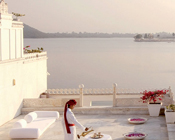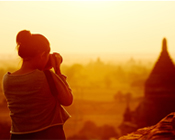Population & Culture
Cultural Heritage
From Agra to Delhi by way of Rajasthan, India is home to monuments of incomparable beauty. Proud protectors of their country’s rich historical and cultural heritage, essential visits include sites like Agra’s Taj Mahal, the second-most visited monument in the world, independent India’s pride, Delhi’s Red Fort, Kajuraho, the second-most visited site in India, and the Qutb Minar. Such a bounty of forts showcasing myriad architectural styles can’t be found anywhere else in the world. Some of the country’s most impressive fortresses and palaces can be found in Rajasthan: Hawal Mahal and the City Palace in Jaipur, Jaisalmer Fort, not to mention Delhi’s Havelis.
On top of all this abundance of great sites, India also offers visitors many festivals of varying origins. In the Indian calendar, there are national, local, regional, religious, seasonal, and social celebrations bursting with color, energy, and enthusiasm. Well-known festivals include the harvest festival (Pongal), the Ganesh festival in Mumbai, and the festival of lights in honor of the goddess Lakshmi. Known as Holi, the spring festival is undoubtedly one of the most popular Hindu celebrations in India. Movie studios also make for an interesting visit. After all, movies are certainly one of the most popular forms of entertainment in India. Each year, Bollywood produces around 900 feature films, placing India at the top of the list of the world’s biggest movie producers.
Customs and lifestyles
Customs and ways of life vary greatly in India, depending largely on region and religion. Vegetarianism, dress code, cows allowed to roam freely in the city, and seeing life as a transitory stage all follow from strong belief in religion, which has a central place in the daily life of Indians. A good example of this is seen in the dress code and the tilak: this mark worn by Hindus on their forehead represents the “third eye” of Shiva or “the eye of truth”. It is also a good luck charm that can indicate social status: married women wear red tilaks, while single women will have black tilaks.
The sari, a traditional garment, can also have many meanings: different colors and ways of wearing these can express a wide variety of moods, events, occasions, ethnic background, and religion. For example, newlyweds will wear crimson, while white symbolizes mourning. To greet someone, join your hands together under your chin and lower your head: some find that shaking hands is impure. Shorts, tank tops, and short skirts should also be avoided.
Also, try to avoid kissing in public or making too many compliments, as this is frowned upon. It is also considered disrespectful to have your feet pointed at the person you are talking to, at religious statues and representations, and to step over someone in a public area.
Cuisine
India boasts many different culinary traditions, which vary according to religion, caste, and region. Spices vary in the same way, which leads to countless novel flavors. This being said, there are two main cuisines in India: vegetarian and non-vegetarian. Some of the best known dishes among the many specialties of this rich and varied culinary tradition include dhal, a lentil-based dish that serves as the basic meal across the country, biryani and pulao (pilaf rice with saffron and cooked with or without meat and fish), rotis (bread), naan and dosai (white flour biscuits and pancakes made from rice and lentil flour). Pastries and sweets also come in a wide variety of shapes and sizes. Make sure you try halwa or kulfi, a pistachio or almond flavored ice cream. But the best way to enjoy the myriad flavors of India is to eat with the locals: recipes are passed down from one generation to the next, carrying with them family secrets that give even more character to an already rich culinary heritage. Apart from the national drink, tea served with milk, people also love masala tea boiled with milk, sugar, cardamom, and countless other spices. Also popular are lassis (plain, sweet, or salty), fresh fruit juices, nimbu pani, limejuice served sweet or salted, and coconut juice straight from the coconut.

 1 (866) 722-0909
1 (866) 722-0909
 QUOTE REQUEST
QUOTE REQUEST 





































